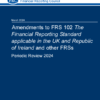
by John McCarthy Consulting Ltd. | Apr 1, 2023 | News
This week we continue our series looking at some lessons that auditors can learn from past Decision Notices (DN) published by the Financial Reporting Council. For the sake of brevity we are omitting the title ‘Ireland’ from the names of the ISAs as we are referring to the Irish ISAs throughout this post.
To catch up on last week’s post in the series click here.
Today we focus on the topic of revenue recognition and recoverability of debtors. Both of these are often considered high-risk areas in many audits. In the audit of the consolidated financial statements for ‘Associated British Engineering plc’ (‘ABE’) for the FY 2018 significant audit risks relating to:
- Revenue recognition and
- Recoverability of debtors
were identified in the audit file as a key audit matter (KAM).
Provision against trade debtors was a significant accounting estimate made by ABE’s management.
ISA 240.32(b) of the Auditor’s Responsibilities Relating to Fraud requires the auditor to design and perform audit procedures to review accounting estimates for biases and evaluate whether the circumstances producing any bias represent a risk of material misstatement due to fraud.
Paragraph 32(b)(ii) requires that such review must include a retrospective review of management judgements and assumptions related to significant accounting estimates reflected in the financial statements of the prior year.
ISA 240.A46 explains that a retrospective review has the purpose of determining whether there is an indication of a possible bias on the part of management.
In the circumstances of the Audit, the Respondents were required by these provisions of ISA 240 to perform a retrospective review of management’s judgements and assumptions related to the provision against trade debtors in ABE’s financial statements for the prior year. The auditors failed to comply with that requirement.
They did not carry out work which met the requirement of ISA 240.32(b)(ii) to conduct a retrospective review on the prior year’s provision against trade debtors. Such audit work as was carried out was inadequate for the purpose of meeting the requirement of ISA 240.A6.
As regards Audit Sampling the relevant section of ISA 530.6 requires the auditor, when designing an audit sample, to:
- consider the purpose of the relevant audit procedure and
- the characteristics of the population from which the sample in question will be drawn.
The auditors failed to comply with this requirement in their audit work on revenue recognition and recoverability of debtors, in that they did not appropriately address the difference between the two classes of ABE’s sales to its customers, namely
- products (predominantly engine parts) and
- services (repair work);
- they did not consider the respective risks presented by those two revenue streams; and
- they did not differentiate between them in the substantive testing work that was carried out for the Audit.
Another problem area related to ISA 701 Communicating Key Audit Matters (‘KAM(note 1) in the Auditor’s Report), by virtue of its paragraphs 9, 10, 13 and 18(a), which require the auditor:
- to determine, from the matters communicated to those charged with governance, those matters that required significant attention in performing the audit;
- to determine which of those matters were of most significance in the audit and therefore formed the KAMs; and
- to record within the audit documentation the significant matters and,
- in respect of each of them, the rationale for the auditor’s determination as to whether or not the matter is a KAM, including (in respect of each matter determined to be a KAM):a reference to any disclosure(s) in the financial statements related to the matter; and information as to:
- why the matter was determined to be a KAM; and
- how the matter was addressed in the
The auditors’ audit work in the area of revenue recognition and recoverability of debtors did not comply with the above requirements of ISA 701 even though this area was identified, both in the audit file and the auditor’s report, as a KAM.
However, the reasoning behind that identification was lacking; the audit team’s assessment of the risks in relation to revenue recognition had in fact led them to a contrary conclusion; and the identification of this matter as a KAM was an error.
Please go to our website to see our new ISQM TOOLKIT or if you prefer to chat through the different audit risks and potential appropriate responses presented by this new standard, please contact John McCarthy FCA by e-mail at john@jmcc.ie.
We typically tailor training and brainstorming sessions to suit your firm’s unique requirements.
Publications and AML webinars:
- The ISQM TOOLKIT 2022 is available to purchase here.
- See our latest Anti-Money Laundering Policies Controls & Procedures Manual (March 2022) – View the Table of Contents click here.
- Also we have an updated AML webinar (March 2022) available here, which accompanies the AML Manual. It explains the current legal AML reporting position for accountancy firms and includes a quiz. Upon completion, you receive a CPD Certificate of attendance in your inbox.
- To ensure your letters of engagement and similar templates are up to date visit our site here where immediate downloads are available in Word format. A bulk discount is available for orders of five or more items if bought together.
[1] Note that KAMS apply most frequently to listed entities but can also apply to circumstances when the auditor decides to communicate key audit matters in the auditors’; report.

by John McCarthy Consulting Ltd. | Mar 20, 2023 | News
This week we continue our series looking at some lessons that auditors can learn from past Decision Notices (DN) published by the Financial Reporting Council. To read last week’s post click here.
Today we focus on the journal entry testing audit failings in the case of Haysmacintyre LLP and its audit partner David Cox (Hays) and the audit of the consolidated financial statements for ‘Associated British Engineering plc’ (‘ABE’) for the FY 2018. The FRC did not make a finding that the FY2018 financial statements of ABE were misstated.
Hays communicated to ABE’s audit committee that “significant, unusual or unexpected journal postings [had] been investigated and verified”.
- However, in fact Hays’ work on journal entry testing failed to meet the Relevant Requirements of ISA 240 Auditor’s Responsibilities Relating to Fraud;
- ISA 500 Audit Evidence; and
- 230 Audit Documentation.
This arose from journal entry testing that did not comply with the requirements of paragraph 32 of ISA 240, and thereby failed to respond appropriately to the risk, present in all entities, that arises from the fact that management is in a unique position to perpetrate fraud by overriding controls.
The rationale of the Relevant Requirements of ISA 240 is that management has the ability to manipulate accounting records and prepare fraudulent financial statements by overriding controls that otherwise appear to be operating effectively.
The work on journal entries that Hays carried out did not meet the requirements in that:
- it did not constitute testing across all journal entries made in the year for the purpose of complying with ISA 240 paragraph 32 and
- was not designed or executed as testing of that kind;
- the work was confined to entries in discrete parts of the accounts and
- was directed to objectives other than those of ISA 240 paragraph 32, such as testing year-end journals as part of balance-sheet testing.
Hays did not document on the audit file the work done to ensure that significant, unusual or unexpected journal postings had been investigated and verified.
Although the relevant workpaper states that journal entries were “reviewed as part of testing, with no evidence of fraud or bias noted”, the workpaper does not:
- set out the audit procedures performed, either by explaining the procedures or attaching documents to substantiate the outcome of the procedures and
- the conclusion reached as to evidence of fraud or bias.
In this area of audit work, Hays therefore breached the requirement of ISA 240 paragraph 32(a),
- by failing to design and perform audit procedures to test the appropriateness of journal entries recorded in the general ledger and other adjustments made in the preparation of the financial statements and,
- in doing so, to make inquiries about inappropriate or unusual activity relating to the processing of the entries, to select entries made at the end of a reporting period and to consider the need to test them throughout the period.
Hays also breached the requirements of:
- ISA 500 (Audit Evidence), paragraph 6, by failing to design and perform appropriate procedures to obtain sufficient appropriate audit evidence; and
- ISA 230 (Audit Documentation), paragraphs 8 and 9, in respect of preparing audit documentation that:
- shows the results of audit procedures performed and
- the audit evidence obtained and documenting the identifying characteristics of the specific items or matters tested.
Please go to our website to see our new ISQM TOOLKIT or if you prefer to chat through the different audit risks and potential appropriate responses presented by this new standard, please contact John McCarthy FCA by e-mail at john@jmcc.ie.
We typically tailor training and brainstorming sessions to suit your firm’s unique requirements.
Publications and AML webinars:
- The ISQM TOOLKIT 2022 is available to purchase here.
- See our latest Anti-Money Laundering Policies Controls & Procedures Manual (March 2022) – View the Table of Contents click here.
- Also we have an updated AML webinar (March 2022) available here, which accompanies the AML Manual. It explains the current legal AML reporting position for accountancy firms and includes a quiz. Upon completion, you receive a CPD Certificate of attendance in your inbox.
- To ensure your letters of engagement and similar templates are up to date visit our site here where immediate downloads are available in Word format. A bulk discount is available for orders of five or more items if bought together.

by John McCarthy Consulting Ltd. | Mar 20, 2023 | News
It can be a very informative learning experience for auditors to focus on the Decision Notices (DN) published by the Financial Reporting Council. This week we focus on the audit failings in a case involving inventory.
One decision that we will examine over the coming weeks is the 2021 DN involving Haysmacintyre LLP and its audit partner David Cox (Hays) and the audit of the consolidated financial statements for ‘Associated British Engineering plc’ (‘ABE’) for the FY 2018. ABE was an engineering company based in the UK whose core operating activity was manufacturing/supplying spare parts for diesel engines and associated repair services.
The FRC clarifies that it did not make a finding that the FY2018 financial statements of ABE were misstated.
The carrying value of ABE’s inventory (i.e. the lower of cost and Net Realisable Value) stated in the FY2018 financial statements, at £1.037 million, represented 55% of current assets and 35% of total assets. There were multiple, serious failures in Hays’ audit work on inventory/stock valuation.
The inventory testing procedures in question were:
- poorly designed and
- were inadequate to test the key elements of the provisioning assessments so as to provide sufficient evidence for the relevant assertions in the FY2018 financial statements.
Sample selection failings
The selected sample size of 30 items was not appropriate, given that inventory was deemed an area of significant risk, and the audit file does not provide a justification for the sample size.
The whole population of the items that could have been selected was many times greater than 30; the audit file itself refers to an alternative, balance-sheet measure which might have been adopted and would have involved a sample more than ten times larger than the selected sample.
Execution of the tests by the audit team was deficient.
Hays communicated to ABE’s audit committee that, for each item within the sample of stock lines they had selected, they had traced:
- the cost price both to a purchase invoice, to ensure that costs had been correctly recorded, and
- to a sales list, to ensure that stock was subsequently recorded at the lower of cost and net realisable value.
In fact, Hays had not carried out those procedures.
Of the 30 items in the sample:
- only 17 were traced to a purchase invoice and
- only 10 were traced to a post year-end sales invoice.
Hays carried out testing work on the stock ageing data of [Subsidiary A], on which management based their provisioning.
The test of [Subsidiary A]’s stock ageing data that Hays designed and executed was inadequate in that it did not seek to verify the ageing data by checking the allocation of purchases to their respective financial periods.
Hays’ work on the carrying value of inventory within the Audit was therefore wholly inadequate. There were extensive and significant failings in this area of the Audit which constitute breaches of the following requirements of the ISAs:
ISA 200 (Overall objectives):
- Paragraph 15, by failing to plan and perform an audit with professional scepticism recognizing that circumstances may exist that cause the financial statements to be materially misstated;
- Paragraph 16, by failing to exercise professional judgment in planning and performing an audit of financial statements; and
- Paragraph 17, by failing to obtain sufficient appropriate audit evidence to reduce audit risk to an acceptably low level and thereby enable the auditor to draw reasonable conclusions on which to base the auditor’s opinion.
ISA 500 (Audit Evidence):
- Paragraph 6, by failing to design and perform appropriate procedures to obtain sufficient appropriate audit evidence; and
- Paragraph 9, by failing to carry out an appropriate evaluation as to whether information produced by the audited entity was sufficiently reliable for the auditor’s purposes.
ISA 330 (Response to Risks)
Paragraph 21, by failing to perform substantive procedures that were specifically responsive to the assessed significant risk of material misstatement in relation to inventory.
ISA 530 (Audit Sampling):
- Paragraph 6, by failing to design an audit sample giving consideration to the purpose of the audit procedure in question and the characteristics of the population from which the sample was to be drawn;
- Paragraph 7, by failing to determine a sample size sufficient to reduce sampling risk to an acceptably low level; and
- Paragraph 10, by failing to perform on a replacement item an audit procedure which was not applicable to the item first selected.
Please go to our website to see our new ISQM TOOLKIT or if you prefer to chat through the different audit risks and potential appropriate responses presented by this new standard, please contact John McCarthy FCA by e-mail at john@jmcc.ie.
We typically tailor training and brainstorming sessions to suit your firm’s unique requirements.
Publications and AML webinars:
- The ISQM TOOLKIT 2022 is available to purchase here.
- See our latest Anti-Money Laundering Policies Controls & Procedures Manual (March 2022) – View the Table of Contents click here.
- Also we have an updated AML webinar (March 2022) available here, which accompanies the AML Manual. It explains the current legal AML reporting position for accountancy firms and includes a quiz. Upon completion, you receive a CPD Certificate of attendance in your inbox.
- To ensure your letters of engagement and similar templates are up to date visit our site here where immediate downloads are available in Word format. A bulk discount is available for orders of five or more items if bought together.

by John McCarthy Consulting Ltd. | Mar 10, 2023 | News
As part of the new ISQM 1 audit quality management standard, there has been much commentary about a new procedure called Root Cause Analysis or RCA.
Root cause analysis is now a compulsory requirement of audit quality control under paragraph 41 of the ISQM. It focuses on understanding the underlying cause behind the deficiencies identified on audit files and in audit quality processes to help provide valuable insights to the firm and help with remedial action.
It’s not practical to apply RCA to every deficiency. Firms will need to design a way of appropriately targeting RCA at the most appropriate reviews and findings.
The selection of deficiencies on which to focus RCA will involve taking the following factors into account:
- The quantum/frequency of the audit risk and/or whether the audit is high profile;
- The reviews it could be applied to, cold file reviews, engagement quality reviews and/or external monitoring reviews;
- The possible selection of all low scoring/graded files, in cold file reviews; and
- Whether the findings in question are recurring themes.
Please go to our website to see our new ISQM TOOLKIT or if you prefer to chat through the different audit risks and potential appropriate responses presented by this new standard, please contact John McCarthy FCA by e-mail at john@jmcc.ie.
We typically tailor training and brainstorming sessions to suit your firm’s unique requirements.
Publications and AML webinars:
- The ISQM TOOLKIT 2022 is available to purchase here.
- See our latest Anti-Money Laundering Policies Controls & Procedures Manual (March 2022) – View the Table of Contents click here.
- Also we have an updated AML webinar (March 2022) available here, which accompanies the AML Manual. It explains the current legal AML reporting position for accountancy firms and includes a quiz. Upon completion, you receive a CPD Certificate of attendance in your inbox.
- To ensure your letters of engagement and similar templates are up to date visit our site here where immediate downloads are available in Word format. A bulk discount is available for orders of five or more items if bought together.

by John McCarthy Consulting Ltd. | Feb 3, 2023 | News
As many audit firms will already be aware the International Standard on Quality Management 1 (ISQM 1) became effective on 15 December 2022. This is the implementation date from when they must document their System of Quality Management (SoQM).
As part of such a system, audit firms must assess the quality of any system components which have been sourced from external third parties.
Part of the confirmation process will involve the collection of statements from these external parties known as Supplier Quality Statements (SQS). We are only concerned here with those suppliers that may impact on audit quality such as (the list is not necessarily comprehensive) the following:
- training organisations providing CPD;
- providers of audit tools such as audit programmes and financial statements checklists;
- professional bodies;
- software and IT support suppliers;
- providers of technical checklists;
- technical advisers and
- audit file reviewers.
The collection of these Supplier Quality Statements will form part of each firm’s System of Quality Management (SoQM) and will need to be updated subsequently at regular intervals.
Have you sourced all the Supplier Quality Statements you need?
In case you ask, here is the one from John McCarthy Consulting Ltd.
For those of you still in the process of ISQM 1 implementation, please see our new ISQM TOOLKIT or if you prefer to chat through the different audit risks and potential appropriate responses presented by this new standard, please call or e-mail John McCarthy FCA or e-mail him at john@jmcc.ie.
We typically tailor training and brainstorming sessions to suit your firm’s unique requirements.
Publications and AML webinar:
- The ISQM TOOLKIT 2022 is available to purchase here.
- See our latest Anti-Money Laundering Policies Controls & Procedures Manual (March 2022) – View the Table of Contents click here.
- Also we have an updated AML webinar (March 2022) available here, which accompanies the AML Manual. It explains the current legal AML reporting position for accountancy firms and includes a quiz. Upon completion, you receive a CPD Certificate of attendance in your inbox.
- To ensure your letters of engagement and similar templates are up to date visit our site here where immediate downloads are available in Word format. A bulk discount is available for orders of five or more items if bought together.










